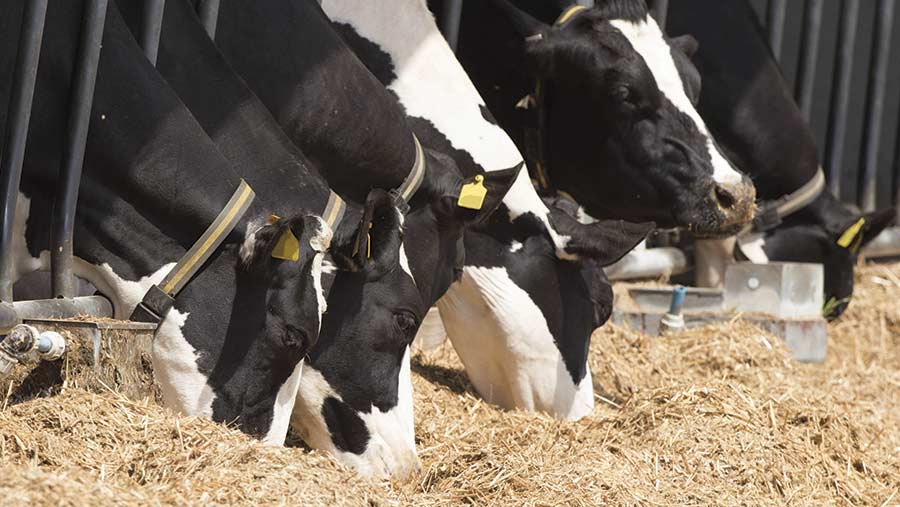Data shows routine testing of forages is key to preventing milk fever
 © Tim Scrivener
© Tim Scrivener All farmers could benefit from routinely testing forage potassium levels in dry cow diets as part of their milk fever prevention strategy, according to vet and nutrition consultant James Husband of the Evidence Group.
Speaking in response to farm data from Friars Moor Vets and Trouw Nutrition he highlighted forage potassium levels as one of the main contributory factors to disease risk.
The data showed 65% of freshly calved cows tested on four farms were found to have subclinical milk fever – defined as blood calcium levels of under 2mmol/litre.
Indirect costs of milk fever equated to as much as £300 a case, with subclinical disease costing around 1ppl, the study found.
See also: Guide to preventing milk fever in your herd
“Potassium is the enemy pre-calving,” he told farmers attending a Friars Moor Vets High Yielders Group discussion meeting at Hinton St Mary Farm, Dorset.
This is due to the fact it makes the cow’s blood more alkaline, which negatively affects the hormonal pathway needed to mobilise calcium from the gut and bones.
This means the cow will struggle to meet its increased requirements for calcium around calving, leading to subclinical or clinical milk fever. This in turn increases the risk of other diseases such as ketosis, metritis and displaced abomasums.
Advice to avoid subclinical milk fever
Mr Husband says avoiding feeding excess calcium in the diet three weeks pre-calving is a must to avoid issues.
Advice overview
- Avoid feeding excess calcium in the diet three weeks before calving
- Reduce potassium intakes – aim for a total dietary potassium level of under 1.5% in the transition diet
- Get forages tested to ensure they are not high in potassium
- Feed stalky grass that has had no muck applied or use lower risk forages
- As a latter defence use a calcium binder pre-calving
Good magnesium status around calving is also important as this also affects calcium mobilisation, he adds.
However one of the main actions is to shift the DCAB (dietary cation anion balance) so the cow’s blood is less alkaline. This means reducing potassium levels and feeding salts with chloride in them, such as magnesium chloride.
As forage is the main component of any dry cow ration, he says this should form the main focus when trying to limit potassium intakes.
“Grass silage can be horribly high in potassium or it can be fine; it can be very tricky to judge. Some grass silages can be as high as 3-4% potassium.”
At such high levels, it is a challenge to achieve a target total dietary potassium level of under 1.5% in the transition diet. As such, he says routinely testing forage mineral levels is advisable.
“At around £40 a test it’s well worth testing forages as routine, especially if you want to use grass silage in the dry cow ration,” he says.
To prevent problems he suggests avoiding feeding dry cows quality grass silage, which is high in potassium. Instead, feeding transition cows grass that has been left to “go over” so it is more stalky and lower in potassium is recommendable, together with avoiding applying muck to ground destined to make forage for dry cows.
Incorporating lower risk forages into the transition diet is also an option. This includes maize at 1-1.5% potassium, wholecrop at 1% and wheat straw at 0.7%.
However, where farmers have done all they can to limit dietary potassium levels and milk fever is still an issue, Mr Husband suggests feeding a calcium binder pre-calving. These work by binding the calcium in the ration to put the cow in negative calcium balance.
This means the hormonal mechanisms to mobilise calcium are up-regulated early and removes the worry of feeding high potassium diets. However, this is not recommended as the first line of defence, due to their high cost.
